|
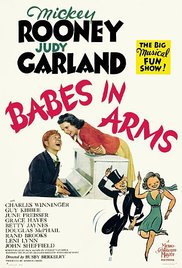 “Hey, let’s put on a show!!!” So goes the famous phrase, spirit, and even plot of every early-career collaboration between young Judy Garland and Mickey Rooney. At least, that’s the common scuttlebutt on this run of stage-centric, performance based Busby Berkeley directed films. Having never seen any of them prior to this exercise, my understanding that they are simplistic but charming, if not essentially interchangeable, seems to have proven correct – at least as far as 1939’s Babes in Arms and 1941’s Babes on Broadway are concerned. “Hey, let’s put on a show!!!” So goes the famous phrase, spirit, and even plot of every early-career collaboration between young Judy Garland and Mickey Rooney. At least, that’s the common scuttlebutt on this run of stage-centric, performance based Busby Berkeley directed films. Having never seen any of them prior to this exercise, my understanding that they are simplistic but charming, if not essentially interchangeable, seems to have proven correct – at least as far as 1939’s Babes in Arms and 1941’s Babes on Broadway are concerned.
Quite evident from the start is the fact that Rooney and Garland go great together. Also evident is Garland’s shockingly broad shoulders – my word, that girl had a frame! Her broader build does nothing to nullify her feminine radiance in the eyes of either Rooney (who falls for her early on in both films) or the audience. When he inevitably gets over-burdened with the demands of whatever makeshift musical show he’s spearheading, and terribly wrongs her in the process (both professionally and emotionally, poor girl) we can only wonder what on Earth has gotten into him.
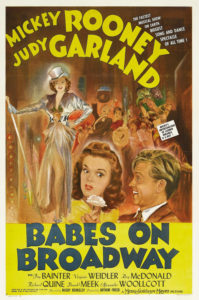 As for the legendary Berkeley, he seems entirely too content to leave his groundbreaking trademark kaleidoscopic camera-centric choreography a few years behind, allowing these Rooney/Garland efforts to be the delightful piffles they’re so clearly meant to be. Berkeley, still no doubt reeling from prolonged court action resulting from two fatalities that occurred when he was reckless at the wheel in 1935, coupled with the fact that the cinematic time of a hundred skimpy-dressed showgirls rising in mechanical pyramid formation from the water was passed, must’ve simply been grateful for the continued film work. As for the legendary Berkeley, he seems entirely too content to leave his groundbreaking trademark kaleidoscopic camera-centric choreography a few years behind, allowing these Rooney/Garland efforts to be the delightful piffles they’re so clearly meant to be. Berkeley, still no doubt reeling from prolonged court action resulting from two fatalities that occurred when he was reckless at the wheel in 1935, coupled with the fact that the cinematic time of a hundred skimpy-dressed showgirls rising in mechanical pyramid formation from the water was passed, must’ve simply been grateful for the continued film work.
Both Babes films feature blackface performances. (!) Oddly enough, Garland displays a great deal of swaggering confidence in the “Mr. Bones” role she plays in both numbers, possibly because her father was himself a blackface performer… And for another strange irony, minstrel shows were largely passe by this point in entertainment, having been replaced by vaudeville which, as the plot to Babes in Arms makes clear, had itself been replaced in popularity by talking pictures. Musta been some pretty singular (not to mention casually racist) turn-of-the-century style “nostalgia” going on in the late 30s/early 40s!
The blackface sequences are frankly shocking. It sneaks up in Arms, then blindsides in Broadway. That one actually puts it off until the massive finale, as the characters actually start their act on stage bored and wondering what to sing. “Hey, I know…! Let’s do A MINSTREL SHOW!” And then, the biggest, longest blackface number anyone’s ever seen. Both films remain charming throwbacks all around these numbers, but amid the lovable shmaltz, there does lurk these nagging reminders of uneasy racial issues.
As great as Judy Garland is in these pictures, Rooney can’t not dominate them. He spends both movies storming in and out of rooms, positively barking up a storm. (Approximated dialogue; read fast:) “Things are rough all over, donchaknow! Times are tough for a hoofer! But by golly, who needs big name producers and theaters when we do it all ourselves, right in our own backyard??” And by gum, they’ll do just that.
Meet Me in St. Louis
(1944, MGM, Dir. Vincente Minnelli)
by Erik Yates
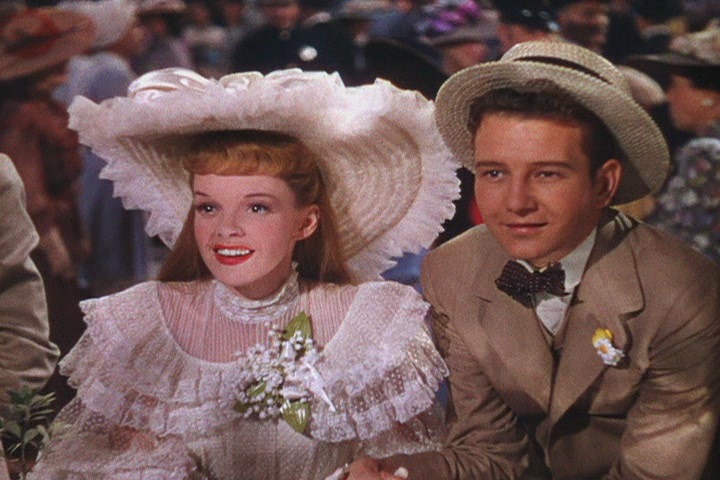
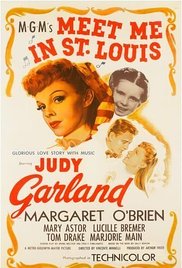 Besides The Wizard of Oz, I cannot remember having seen a single film staring Judy Garland. I’ve heard the songs of course, and seen clips of her singing and dancing, particularly the films with Mickey Rooney. And I, of course was familiar with her being the mother of Liza Minnelli. This film is directed by Liza’s father, Vincente Minnelli, and is the film where he and Judy met. Besides The Wizard of Oz, I cannot remember having seen a single film staring Judy Garland. I’ve heard the songs of course, and seen clips of her singing and dancing, particularly the films with Mickey Rooney. And I, of course was familiar with her being the mother of Liza Minnelli. This film is directed by Liza’s father, Vincente Minnelli, and is the film where he and Judy met.
As a 22 year old, she was trying desperately to leave behind the young roles she had become famous for and longed to be taken as a serious actress, and more importantly, as a grown-up. Vincente promised to capitalize on her beauty and not stereotype her. Instead, throughout the film, Garland is framed in each close up shot as a way of accenting her beauty, and showing her as a girl all grown up, despite playing the 2nd oldest girl of 4 in the Smith family who is preparing to leave St. Louis for New York.
The film is set at the time of the 1904 World’s Fair where St. Louis was taking the world stage despite being a somewhat small “big” town. Having lived in St. Louis for a few years, I became overly familiar with the title song, as it is used for the local outdoor theater there, The Muny, as in “Meet me at the Muny…..the Muny at Forest Park”, instead of the original lyrics. SNL had a hilarious skit with “The Trolly Song” years ago, and everyone knows “Have Yourself a Merry Little Christmas”. The film itself is rather bland and slow, but many people have kind memories of it, and it definitely encapsulated a romantic era in St. Louis history, and one for MGM musicals as well. It also led to the union that brought us Liza Minnelli, who despite the caricature she has become on reality television will always hold a special place in my heart for her roles in Arthur and Arrested Development.
Judgement at Nuremberg
(1961, Roxlom Films Inc., Dir. Stanley Kramer)
by Robert Hornak
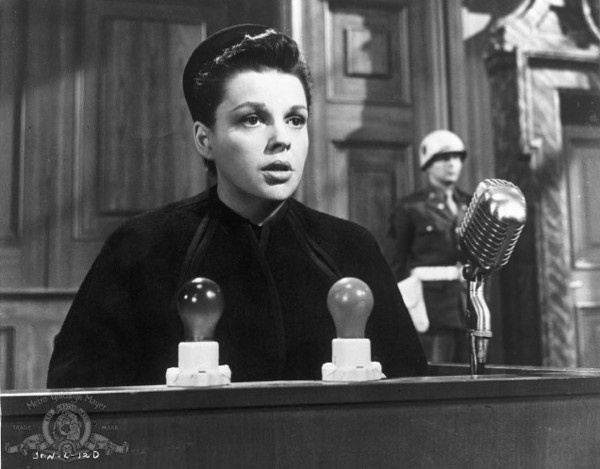
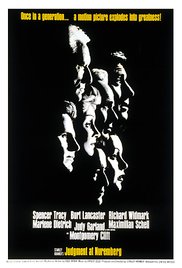 One of several crowning jewels in Stanley Kramer’s headier-than-thou resume, a brow-furrowed, three-hour adjudication of Nazi war criminals that’s given thankful respite from its melancholy by the periodic display of Marlene Dietrich’s cheekbones. We move through the opening formalities of establishing Spencer Tracy’s tribunal judge character as an everyman (“a hick like me”), a man of principle!, but who we’re told, in several not-so-subtle strokes, should only be understood as the exact opposite of someone who’d fanatically obey the rules like those in the dock. Thus our avuncular and inquisitive conscience-of-the-film is thrust into a case nobody wanted – presiding over the judging of judges who may or may not share partial responsibility for sending Jews to their death in concentration camps during WW2 – and we settle into the rhythm of the movie: a sort of American Idol-like rotation of great actors doing great turns on the stand. These sobering testimonies build upon each other, assisted by several cinematically forward-looking snap-zooms, generating nothing so clear as an easy reckoning of their individual guilt, but at least creating intensely watchable drama, culminating unsettlingly in the prosecution’s courtroom projection of sickening, damning film footage of spent and bulldozed victims at the liberated/death-shrouded camps. One of several crowning jewels in Stanley Kramer’s headier-than-thou resume, a brow-furrowed, three-hour adjudication of Nazi war criminals that’s given thankful respite from its melancholy by the periodic display of Marlene Dietrich’s cheekbones. We move through the opening formalities of establishing Spencer Tracy’s tribunal judge character as an everyman (“a hick like me”), a man of principle!, but who we’re told, in several not-so-subtle strokes, should only be understood as the exact opposite of someone who’d fanatically obey the rules like those in the dock. Thus our avuncular and inquisitive conscience-of-the-film is thrust into a case nobody wanted – presiding over the judging of judges who may or may not share partial responsibility for sending Jews to their death in concentration camps during WW2 – and we settle into the rhythm of the movie: a sort of American Idol-like rotation of great actors doing great turns on the stand. These sobering testimonies build upon each other, assisted by several cinematically forward-looking snap-zooms, generating nothing so clear as an easy reckoning of their individual guilt, but at least creating intensely watchable drama, culminating unsettlingly in the prosecution’s courtroom projection of sickening, damning film footage of spent and bulldozed victims at the liberated/death-shrouded camps.
During the final hour, we drift from the driving question of whether these men were acting in the country’s best, long-viewed interests by cowing to Hitler today and into the more abstract question of whether Tracy will sentence these men as harshly as we know he wants to now that Germany (and Germany’s good will vis-à-vis America) is needed to help fight the Russkies in the suddenly looming Cold War tomorrow. It’s a shift in focus that makes the movie relevant for all time, as leaders are constantly balance-beaming the cry for social justice and the need for international détente.
As for (Oscar-nominated) Judy Garland, my heart goes out, certainly to her character, but more so to Garland herself. She plays a woman who is suffering through an invasive re-trial of sorts for supposedly being intimate with an older Jewish man, a bold violation of the fascistic Nuremberg Laws established by Hitler in the 30s. But while her performance is imbued with her always believable, wounded-bird tremble, her arrival to the story falls soon enough after a truly heartbreaking scene by (also Oscar-nominated) Montgomery Clift – whose mentally fractured, sexually emasculated character must testify to his own unfair chemical castration at the hands of unscrupulous doctors – and is so tightly flanked on all sides by rarely-better (also Oscar-nominated) Burt Lancaster and (Oscar-winning) Maximilian Schell, all spouting Abby Mann’s Oscar-winning script, that to my first-viewing eyes, her bona-fides are effectively swamped out. I guess we can blame the Academy for making the movie a rank acting contest, so forgive me if I say that Judy’s three-scene arc is good, but Monty’s lone, ten-minute compendium of squirmy, cornered helplessness made me cry.
The Harvey Girls
(1946, MGM, Dir. George Sidney)
by Sharon Autenrieth
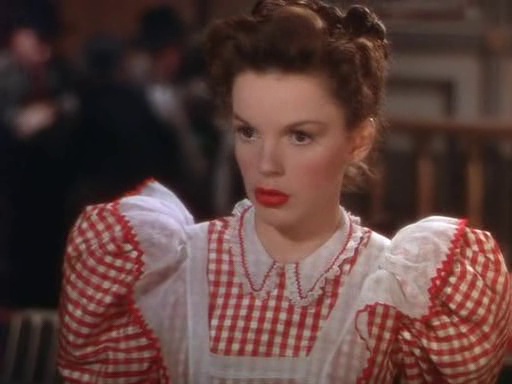
 There’s a bit of authentic American history in The Harvey Girls. There really was a chain of restaurants called Harvey Houses built alongside the railroads in the Western U.S., starting in 1875. And over 100,000 young women really responded to Fred Harvey’s employment ads and worked as Harvey girls, just as Judy Garland does in this 1946 musical, directed by George Sidney (Anchors Aweigh, Bye Bye Birdie). There’s a bit of authentic American history in The Harvey Girls. There really was a chain of restaurants called Harvey Houses built alongside the railroads in the Western U.S., starting in 1875. And over 100,000 young women really responded to Fred Harvey’s employment ads and worked as Harvey girls, just as Judy Garland does in this 1946 musical, directed by George Sidney (Anchors Aweigh, Bye Bye Birdie).
Early in The Harvey Girls there’s an extended song and dance sequence to the Henry Warren/Johnny Mercer classic, “The Atchison, Topeka and the Santa Fe”. It’s wonderful fun, evoking memories of Oklahoma and Seven Brides for Seven Brothers – other, later musical celebrations of Western pioneer spirit. But this scene is unfortunately the best that The Harvey Girls has to offer, and the rest of the movie is a thoroughly middling musical.
Judy Garland is as likable as ever. She is tiny, even among the other Harvey Girls, and her character, Susan Bradley, is a spitfire who speaks her mind. It’s always seemed to me that there was something plaintive and pleading in Judy Garland’s expression in every movie – and it’s here, too. No one could well up with tears more effectively than Judy Garland, because the tears always seemed so close to the surface even in happy moments.
It’s a delight to see Garland reunited with Ray Bolger (the Scarecrow in The Wizard of Oz) as the new blacksmith in town. His impressive footwork is put to use in more than one scene. Marjorie Main (of Ma and Pa Kettle fame) is present, too, as the head cook at the new Harvey House in Sandrock, Arizona. Unforgettable character actor Chill Wills is Susan’s almost-husband, and Angela Lansbury reigns as the towering, imperious, dance-hall girl, Em. A young Cyd Charisse is even here as a dreamy, dancing Harvey Girl.
But this a romance, and I’m still trying to decide what I think of casting John Hodiak (Lifeboat) as the saloon owner who wins Susan’s heart. There’s something brutal and predatory about his look – which may serve well as a “don’t judge a book by its cover” moral of the story. I didn’t quite buy it.
My real problem was with the film’s depiction of “good women” (those who bring their civilizing influence on these untamed men of the West) and “bad women” – the dance-hall girls, presumably prostitutes. There’s a scene in which the dance-hall girls attend a social thrown by the Harvey Girls and try, without success, to find any men who will waltz with them. It’s considered a triumph for respectability when they are spurned. By the end of the movie they’ve been dispossessed from Sandrock entirely. It reminded me of Dallas (Claire Trevor), the “bad woman” in the classic John Ford western Stagecoach – a woman who receives similar treatment from the concerned citizens, but who is portrayed much more sympathetically. Women did what they had to in order to survive in the West, because as Dallas said, “You gotta live, no matter what happens.”
The Harvey Girls redeemed itself a bit by allowing some mutual understanding between Susan and Em in the film’s final scene, even if Em is clearly the loser. And here, again, the sadness behind Judy Garland’s eyes make believable her character’s last-act compassion for a woman who has had a very different life than her own.
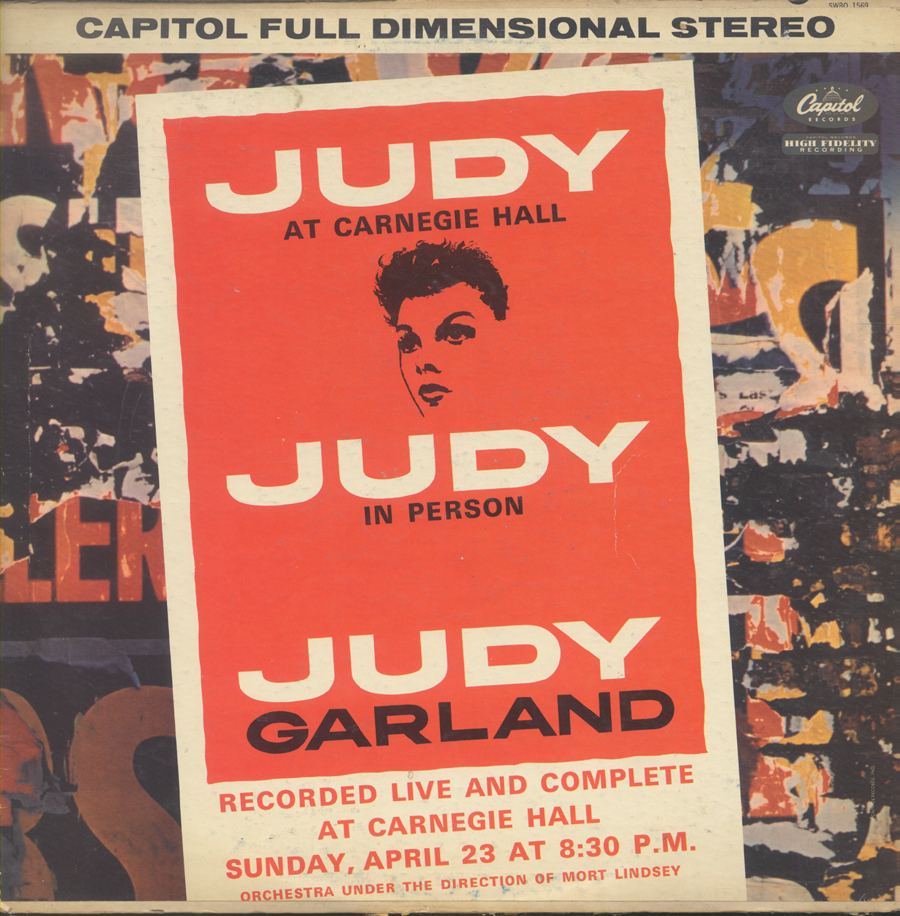
|
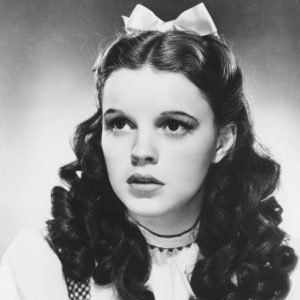 Wind her up. let her go, and stand back! When it came to Judy Garland, that was the prevailing wisdom among MGM’s musical makers back in Hollywood’s golden age. As evidenced in her show-stopping “Be A Clown” number in her then-husband Vincente Minnelli’s notorious 1948 debacle, The Pirate, she belonged on a stage, and nowhere else – singing, dancing, and even clowning. This is not to say that Garland was a poor actress. She could be quite good – surprisingly so – when she wanted to be. But performing – entertaining – was her forte. When burdened with a bunch of plot and subtext (again, see the final act of The Pirate), she was simply out of her natural element.
Wind her up. let her go, and stand back! When it came to Judy Garland, that was the prevailing wisdom among MGM’s musical makers back in Hollywood’s golden age. As evidenced in her show-stopping “Be A Clown” number in her then-husband Vincente Minnelli’s notorious 1948 debacle, The Pirate, she belonged on a stage, and nowhere else – singing, dancing, and even clowning. This is not to say that Garland was a poor actress. She could be quite good – surprisingly so – when she wanted to be. But performing – entertaining – was her forte. When burdened with a bunch of plot and subtext (again, see the final act of The Pirate), she was simply out of her natural element.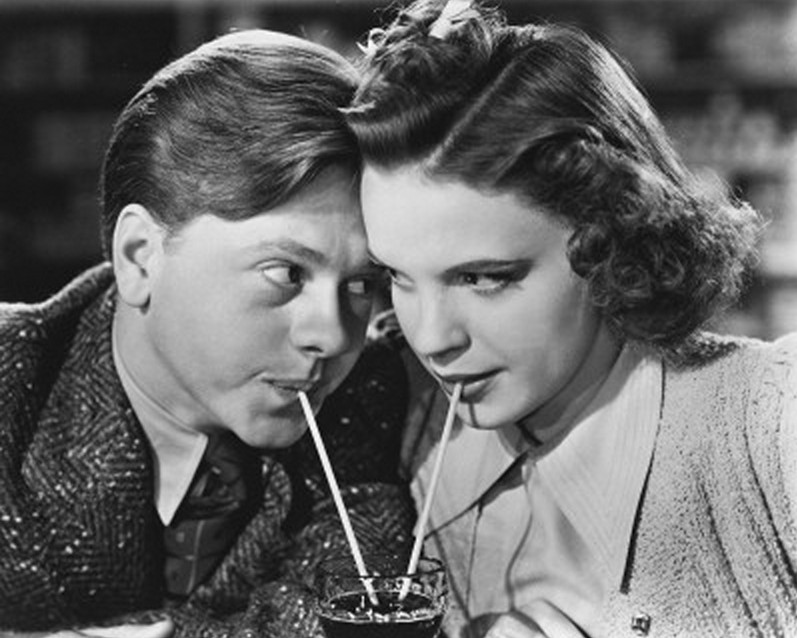



 “Hey, let’s put on a show!!!” So goes the famous phrase, spirit, and even plot of every early-career collaboration between young Judy Garland and Mickey Rooney. At least, that’s the common scuttlebutt on this run of stage-centric, performance based Busby Berkeley directed films. Having never seen any of them prior to this exercise, my understanding that they are simplistic but charming, if not essentially interchangeable, seems to have proven correct – at least as far as 1939’s Babes in Arms and 1941’s Babes on Broadway are concerned.
“Hey, let’s put on a show!!!” So goes the famous phrase, spirit, and even plot of every early-career collaboration between young Judy Garland and Mickey Rooney. At least, that’s the common scuttlebutt on this run of stage-centric, performance based Busby Berkeley directed films. Having never seen any of them prior to this exercise, my understanding that they are simplistic but charming, if not essentially interchangeable, seems to have proven correct – at least as far as 1939’s Babes in Arms and 1941’s Babes on Broadway are concerned. As for the legendary Berkeley, he seems entirely too content to leave his groundbreaking trademark kaleidoscopic camera-centric choreography a few years behind, allowing these Rooney/Garland efforts to be the delightful piffles they’re so clearly meant to be. Berkeley, still no doubt reeling from prolonged court action resulting from two fatalities that occurred when he was reckless at the wheel in 1935, coupled with the fact that the cinematic time of a hundred skimpy-dressed showgirls rising in mechanical pyramid formation from the water was passed, must’ve simply been grateful for the continued film work.
As for the legendary Berkeley, he seems entirely too content to leave his groundbreaking trademark kaleidoscopic camera-centric choreography a few years behind, allowing these Rooney/Garland efforts to be the delightful piffles they’re so clearly meant to be. Berkeley, still no doubt reeling from prolonged court action resulting from two fatalities that occurred when he was reckless at the wheel in 1935, coupled with the fact that the cinematic time of a hundred skimpy-dressed showgirls rising in mechanical pyramid formation from the water was passed, must’ve simply been grateful for the continued film work.
 Besides The Wizard of Oz, I cannot remember having seen a single film staring Judy Garland. I’ve heard the songs of course, and seen clips of her singing and dancing, particularly the films with Mickey Rooney. And I, of course was familiar with her being the mother of Liza Minnelli. This film is directed by Liza’s father, Vincente Minnelli, and is the film where he and Judy met.
Besides The Wizard of Oz, I cannot remember having seen a single film staring Judy Garland. I’ve heard the songs of course, and seen clips of her singing and dancing, particularly the films with Mickey Rooney. And I, of course was familiar with her being the mother of Liza Minnelli. This film is directed by Liza’s father, Vincente Minnelli, and is the film where he and Judy met.
 One of several crowning jewels in Stanley Kramer’s headier-than-thou resume, a brow-furrowed, three-hour adjudication of Nazi war criminals that’s given thankful respite from its melancholy by the periodic display of Marlene Dietrich’s cheekbones. We move through the opening formalities of establishing Spencer Tracy’s tribunal judge character as an everyman (“a hick like me”), a man of principle!, but who we’re told, in several not-so-subtle strokes, should only be understood as the exact opposite of someone who’d fanatically obey the rules like those in the dock. Thus our avuncular and inquisitive conscience-of-the-film is thrust into a case nobody wanted – presiding over the judging of judges who may or may not share partial responsibility for sending Jews to their death in concentration camps during WW2 – and we settle into the rhythm of the movie: a sort of American Idol-like rotation of great actors doing great turns on the stand. These sobering testimonies build upon each other, assisted by several cinematically forward-looking snap-zooms, generating nothing so clear as an easy reckoning of their individual guilt, but at least creating intensely watchable drama, culminating unsettlingly in the prosecution’s courtroom projection of sickening, damning film footage of spent and bulldozed victims at the liberated/death-shrouded camps.
One of several crowning jewels in Stanley Kramer’s headier-than-thou resume, a brow-furrowed, three-hour adjudication of Nazi war criminals that’s given thankful respite from its melancholy by the periodic display of Marlene Dietrich’s cheekbones. We move through the opening formalities of establishing Spencer Tracy’s tribunal judge character as an everyman (“a hick like me”), a man of principle!, but who we’re told, in several not-so-subtle strokes, should only be understood as the exact opposite of someone who’d fanatically obey the rules like those in the dock. Thus our avuncular and inquisitive conscience-of-the-film is thrust into a case nobody wanted – presiding over the judging of judges who may or may not share partial responsibility for sending Jews to their death in concentration camps during WW2 – and we settle into the rhythm of the movie: a sort of American Idol-like rotation of great actors doing great turns on the stand. These sobering testimonies build upon each other, assisted by several cinematically forward-looking snap-zooms, generating nothing so clear as an easy reckoning of their individual guilt, but at least creating intensely watchable drama, culminating unsettlingly in the prosecution’s courtroom projection of sickening, damning film footage of spent and bulldozed victims at the liberated/death-shrouded camps.
 There’s a bit of authentic American history in The Harvey Girls. There really was a chain of restaurants called Harvey Houses built alongside the railroads in the Western U.S., starting in 1875. And over 100,000 young women really responded to Fred Harvey’s employment ads and worked as Harvey girls, just as Judy Garland does in this 1946 musical, directed by George Sidney (Anchors Aweigh, Bye Bye Birdie).
There’s a bit of authentic American history in The Harvey Girls. There really was a chain of restaurants called Harvey Houses built alongside the railroads in the Western U.S., starting in 1875. And over 100,000 young women really responded to Fred Harvey’s employment ads and worked as Harvey girls, just as Judy Garland does in this 1946 musical, directed by George Sidney (Anchors Aweigh, Bye Bye Birdie).